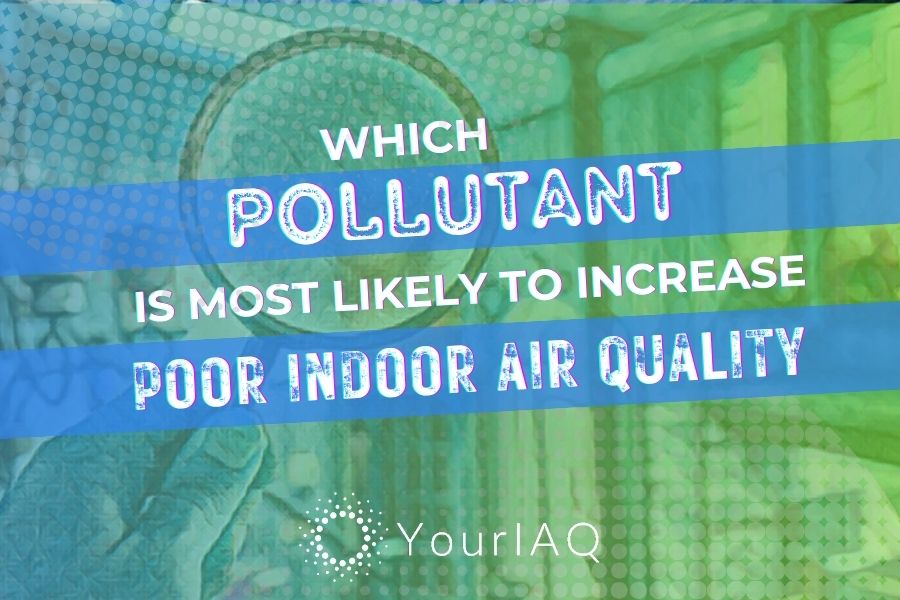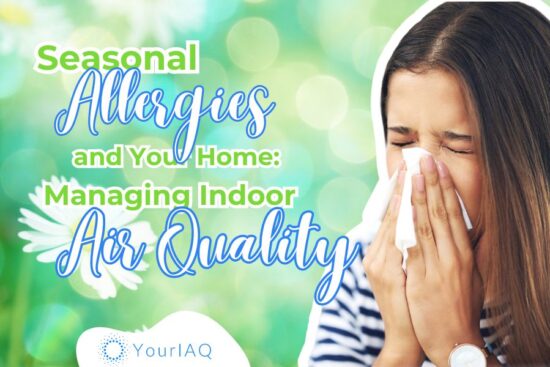
Air inside our homes can be up to five times more polluted than the air outside, according to the EPA. This is especially concerning when we spend 90% of our time indoors, where we’re most exposed to these pollutants.
It’s a startling data point that throws open the curtains on a hidden drama unfolding within the sanctuary we call home. Understanding the possible sources of indoor air pollution is essential in addressing this issue effectively.
In this article, we will explore various factors that contribute to poor indoor air quality, including indoor contaminants, combustion products, building materials, and biological agents. By identifying these sources, we take the necessary steps to minimize exposure and improve the air we breathe.
Factor #1: Common Indoor Pollutants
Indoor air pollutants originate from a variety of sources within our homes and buildings. Some common indoor contaminants include asbestos, biological agents, building materials, radon, tobacco smoke, and heating devices such as wood stoves and gas ranges.
Asbestos
Asbestos, a hazardous material commonly found in older homes, can be present in various forms, such as pipe and furnace insulation materials, shingles, millboard, textured paints, floor and ceiling tiles, and panels. While intact and undisturbed asbestos-containing materials pose minimal risk, improper removal or disturbance can release asbestos fibers into the air, leading to severe health issues like lung cancer, asbestosis, and mesothelioma.
IMPORTANT NOTE:
According to the Consumer Product Safety Commission, maintaining the undisturbed state of asbestos materials is crucial to preventing the release of potentially harmful fibers into the air.
Biologic Agents
Biologic agents that contribute greatly to poor indoor air quality include:
- Animal dander
- Saliva
- Urine
- Bacteria
- Cockroaches
- House dust mites
- Molds
- Pollen and
- Viruses
These agents are introduced into our homes through plants, people, animals, and even contaminated central air handling systems. Allergic reactions, respiratory illnesses, and infectious diseases are some of the health problems associated with exposure to biological pollutants.
What to do?
Regular grooming and keeping pet-friendly areas clean become acts of both affection and environmental responsibility, as Dr. Martha Hartz, an immunologist at the Mayo Clinic, points out: “Up to 30% of adults and 10% of children in the US are allergic to pets,” and regular maintenance “minimize dander levels and improve indoor air quality for allergy sufferers.”
Building Materials
Certain building materials and home improvement products release harmful substances into the air, negatively impacting indoor air quality. For example, pressed wood products made with adhesives containing urea-formaldehyde resins release formaldehyde gas, which causes eye and throat irritation, nausea, breathing difficulties, and, in some cases, even cancer.
Tip:
Proper ventilation and the use of low-emission materials help mitigate the risks associated with indoor air pollution from building materials.
Radon
Radon, a radioactive gas, is a natural byproduct of uranium decay in soil and rock. It can seep into buildings through dirt floors, cracks in concrete walls and floors, floor drains, and sumps. Prolonged exposure to elevated levels of radon can significantly increase the risk of lung cancer. It is crucial to test for radon levels in homes and take appropriate measures to mitigate its presence.
Related reading: Radon Awareness Month: Protect Yourself from the Silent Killer
Tobacco Smoke
Environmental tobacco smoke, also known as secondhand smoke, is a mixture of smoke from the burning end of cigarettes, pipes, or cigars, as well as smoke exhaled by the smoker. Secondhand smoke contains more than 4,000 compounds, with over 60 known to cause cancer in humans or animals.
Children, in particular, are more susceptible to the harmful effects of secondhand smoke, which can lead to respiratory issues such as pneumonia, bronchitis, and bronchiolitis.
Heating Devices
Improperly installed or maintained chimneys and flues, cracked furnace heat exchangers, and fireplaces or woodstoves without dedicated outdoor air supplies can contribute to the release of pollutants into the living space. When these devices do not operate efficiently, they release noxious substances such as carbon monoxide, nitrogen dioxide, particulates, and hydrocarbons.
Studies have shown that children living in homes heated with wood stoves have a higher incidence of respiratory symptoms compared to children in homes without wood stoves. Gas ranges, commonly used for cooking, also produce nitrogen oxide, a respiratory irritant. Unvented kerosene heaters can also generate acid aerosols, further exacerbating indoor air pollution.
See also: The Threatening 13: Most Common Indoor Air Pollutants According to the EPA
Factor #2: Volatile Organic Compounds
Forget the visible fumes clinging to the air after cleaning. The real drama unfolding in your home is a silent symphony of chemicals – a “discordant harmony,” as Dr. Mark Allen, a pulmonologist at the National Jewish Health Institute, aptly describes it. These invisible performers are volatile organic compounds (VOCs) like formaldehyde, benzene, and toluene, lurking in seemingly innocent places like cleaning products, air fresheners, and even fragrant candles.
Take a seemingly harmless act like opening a new piece of furniture. Suddenly, the “off-gassing orchestra takes the stage,” unleashing a cacophony of VOCs. As Dr. Allen warns, these volatile molecules irritate your eyes, trigger allergies, and even lead to respiratory problems.
The EPA estimates that VOC levels in new furniture can be 50-300 times higher than outdoor levels, highlighting the insidious nature of these invisible threats.
These VOCs wreak havoc in several ways:
- Respiratory Irritants: They can irritate the eyes, nose, throat, and lungs, causing headaches, dizziness, nausea, and even difficulty breathing. The effects can be even more pronounced for individuals with asthma or pre-existing respiratory conditions.
- Allergy Triggers: Certain VOCs can trigger allergies, causing symptoms like sneezing, coughing, and itchy eyes.
- Carcinogens and Toxins: While not all VOCs are directly linked to cancer, some, like formaldehyde, are listed as carcinogens by the International Agency for Research on Cancer (IARC). Long-term exposure to these chemicals can increase the risk of developing respiratory cancers and other health problems.
- Hormone Disruptors: Some VOCs have been shown to disrupt the body’s hormonal balance, potentially affecting fertility, thyroid function, and even fetal development.
Factor #3: Leaky Roofs and Poor Ventilation
Leaky roofs and poor ventilation provide the perfect setting for the dreaded mold duo. Not content with just causing unsightly stains, mold spores wreak havoc on our respiratory systems, triggering allergies, asthma, and even lung infections.
According to the World Health Organization, “exposure to mold spores can worsen existing respiratory conditions like asthma and allergies.” Mudarri and Fisk’s report further estimates that “20% of asthma cases may be attributable to dampness and mold in homes.”
Dr. Sarah Jackson, allergist at the American Academy of Allergy, Asthma & Immunology, emphasizes the importance of maintaining proper humidity levels and addressing dampness issues to keep this villainous duo at bay.
Factor #4: Outdoor Air Pollution
Outdoor air pollution, a formidable force in its own right, doesn’t just stay outside. It sneaks through cracks and windows, adding its own cocktail of harmful particles and chemicals to the indoor mix. The American Lung Association reminds us that “outdoor air pollution contributes to 4% of global deaths and is responsible for an estimated 6.7 million premature deaths annually,” with proper ventilation and air filtration playing a crucial role in “significantly reducing the impact of outdoor pollutants on indoor air quality.”
Related reading: The Relationship Between Outdoor Pollution and Indoor Air
Your Home’s Air Quality Scorecard: Understanding the Air Quality Index (AQI)
We have identified the factors that affect the quality of the air inside your home. But how can we measure the extent of this negative impact? This is where the Air Quality Index (AQI) comes in. It acts as a guide to help you navigate the complex world of indoor air quality.
Think of your home’s air quality like a car’s speedometer: the higher the AQI number (on a scale of 0 to 500), the more potential pollutants lurking. This handy index measures key indoor threats like VOCs, PM2.5, and carbon monoxide, using color codes for easy understanding:
- Green (0-50): Good air quality, breathe easy!
- Yellow (51-100): Moderate air quality, consider ventilation and reducing certain activities.
- Orange (101-150): Unhealthy for sensitive groups, take action to improve air quality.
- Red (151-200): Unhealthy for everyone, immediate action is needed to reduce pollution.
- Purple (201-300): Very unhealthy air, evacuate and seek medical advice if necessary.
- Maroon (301-500): Hazardous air quality, immediate evacuation required.
Regularly monitoring your AQI with an air quality monitor helps identify “hotspots” and target your efforts.
See also: What Is an Air Quality Alert and Why Does It Matter?
Strategies for Improving Indoor Air Quality
The importance of maintaining good indoor air quality cannot be overstated. Here are some strategies to help improve indoor air quality:
- Proper Ventilation: Ensure adequate ventilation in your home to allow fresh air to circulate and dilute pollutants. Use exhaust fans in kitchens and bathrooms, and open windows whenever possible to promote air exchange.
- Regular Maintenance: Regularly maintain and service heating devices, chimneys, and flues to ensure they operate efficiently and do not release harmful pollutants into the air.
- Use Low-Emission Materials: To minimize the release of harmful substances into the air, opt for building materials, furnishings, and cleaning products with low (VOC) emissions.
- Control Moisture: Address any moisture issues promptly to prevent the growth of mold and mildew, which can contribute to poor indoor air quality. Use dehumidifiers and ensure proper ventilation in damp areas.
- Avoid Smoking Indoors: Completely eliminate smoking indoors to prevent the release of secondhand smoke and its harmful effects on indoor air quality.
- Test for Radon: Test your home for radon levels and take appropriate measures to reduce radon concentrations if necessary.
- Maintain a Clean Indoor Environment: Regularly clean and vacuum your home to minimize the accumulation of dust, dirt, and allergens. Use high-efficiency particulate air (HEPA) filters in vacuum cleaners to capture fine particles effectively.
- Use Air Purifiers: Consider using air purifiers with HEPA filters to remove airborne pollutants and improve indoor air quality.
- Promote Good Ventilation in Workplaces: Employers should ensure proper ventilation systems in workplaces to provide employees with clean and healthy air.
Conclusion
The truth is there are numerous factors that increase poor indoor air quality. No factor can be singled out as the main contributor to a pronounced decline in IAQ. Poor air quality is often a cocktail of different pollutants working together. More importantly, bad indoor air quality has detrimental effects on our health, particularly for vulnerable individuals such as women, children, and the elderly.
Understanding the sources of indoor air pollution and taking appropriate measures to minimize exposure is vital for ensuring a healthy indoor environment. By addressing indoor contaminants and combustion products and adopting strategies to improve indoor air quality, we can create safer and cleaner living spaces for everyone.
Factors That Increase Poor Indoor Air Quality: FAQs
How do I know if my home has poor IAQ?
Invest in an air quality monitor to measure pollutant levels. Visible mold growth, strong odors, and excessive dust are also red flags.
What are the most common symptoms of poor IAQ?
Headaches, fatigue, dizziness, allergies, and respiratory irritation can all be signs of polluted indoor air.
What are some quick tips for improving indoor air quality?
Ensure good ventilation, use air purifiers, eliminate tobacco smoke, and keep indoor humidity levels in check.
How can I reduce exposure to indoor air pollutants?
Regularly maintain HVAC systems, use natural cleaning products, and minimize the use of synthetic fragrances.
Can indoor plants help improve indoor air quality?
While plants can help, they typically do not do enough to reduce the primary factors that increase poor indoor air quality. Their impact on indoor air quality is limited compared to other measures like proper ventilation and air filtration.







